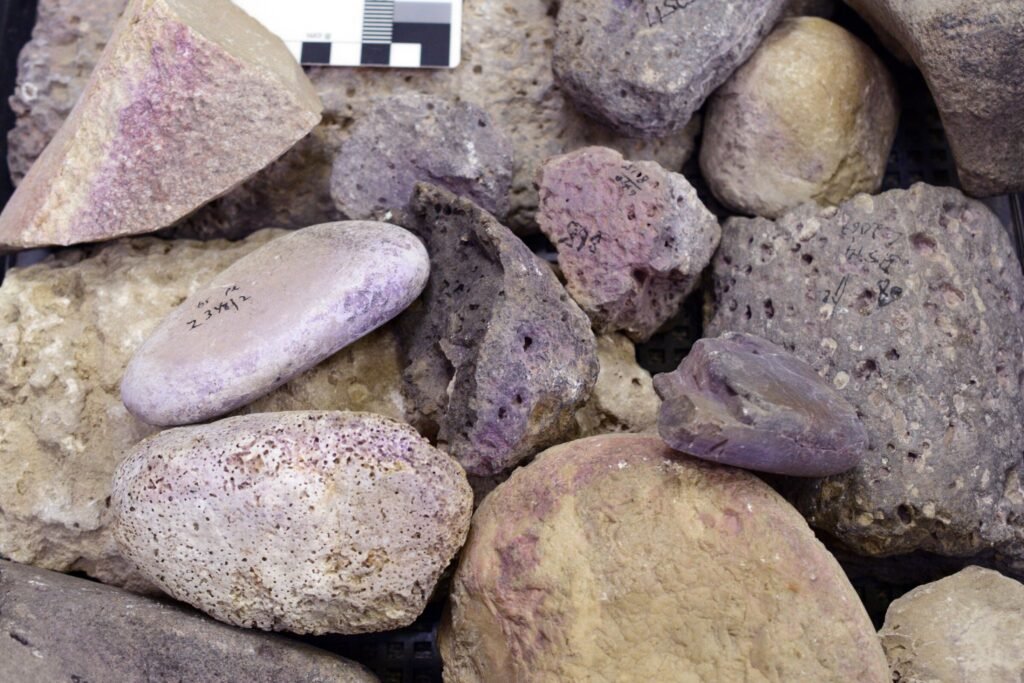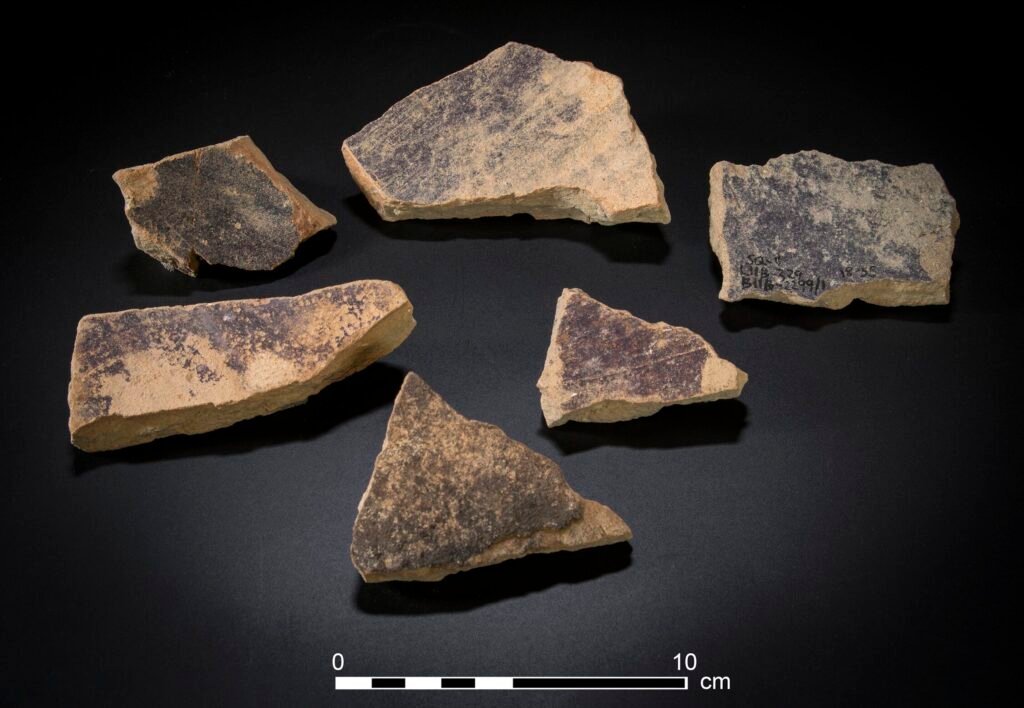Along the serene shores of modern-day Haifa, beneath the sun-soaked soil of what was once a humble fishing village, a team of archaeologists and anthropologists has uncovered a spectacular window into the industrial heart of the Iron Age. At Tel Shiqmona, a coastal site overlooking the Mediterranean Sea, researchers have discovered what they now believe to be the largest known industrial-scale facility for the production of Tyrian purple, the legendary dye that once adorned the robes of emperors, priests, and aristocrats across the ancient world.
This groundbreaking discovery, recently detailed in the journal PLOS ONE, does far more than locate a missing piece of a colorful puzzle. It offers stunning insights into ancient manufacturing, trade, and the cultural significance of color itself in human history.
The Color of Power: Tyrian Purple in the Iron Age
In the ancient Mediterranean, Tyrian purple was not just a color—it was a statement. It symbolized wealth, authority, and the divine. From the courts of Phoenician kings to Roman senators and Byzantine emperors, purple garments were reserved for the elite. The dye’s scarcity and brilliance made it one of the most expensive and sought-after commodities in the ancient world.
The color had a unique brilliance that resisted fading, and its production was notoriously labor-intensive and secretive. Historical records, from Homer to Pliny the Elder, spoke of the remarkable dye extracted from the mucus of certain sea snails, primarily Murex species. The process was gruesome and laborious: thousands of snails were required to produce even a few grams of the dye. But the result—a radiant, almost otherworldly purple—was worth its weight in silver.
Yet, for all its historical significance, the industrial heart of Tyrian purple production had long eluded archaeologists. Evidence of small-scale workshops had surfaced over the years, but no one had found the large-scale facilities capable of producing enough dye to serve vast kingdoms and empires. Until now.
Tel Shiqmona: A Village with a Hidden Secret
Nestled beside the gleaming blue waters of the Mediterranean, Tel Shiqmona was previously known primarily as a modest fishing village. The site, not far from modern-day Haifa in northern Israel, had been occupied for millennia, with archaeological layers spanning from the Bronze Age to Byzantine times. But no one suspected that beneath its sandy topsoil lay the remnants of an ancient industrial complex.
Led by a collaborative team from institutions in the U.S. and Israel, archaeologists initiated a meticulous excavation at Tel Shiqmona. What they found stunned even the most seasoned among them.
Buried beneath centuries of sediment and silence, the team unearthed large stone vats—each capable of holding up to 350 liters of liquid—stained with the unmistakable hue of Tyrian purple. These vats were not isolated; they were part of a network of workshops and workspaces, connected by purpose and function.

In total, the team documented 176 dye-related artifacts, ranging from stone tools and grinding basins to ceramic vessels and organic residues. Taken together, the evidence pointed not just to dye production, but to a coordinated and large-scale industrial operation unlike anything previously documented in the region.

From Mucus to Majesty: The Ancient Chemistry of Purple Dye
The process of turning sea snail mucus into vibrant purple dye was as complex as it was pungent. The Murex snail excretes a yellow-green mucus as a defense mechanism. When exposed to air and sunlight, it undergoes a photochemical reaction, gradually darkening through blue and red hues until it reaches a deep purple.
To capture this precious substance, ancient dye-makers had to harvest enormous quantities of snails from the sea. The snails were then crushed or pierced to extract the gland that contained the dye precursor. From there, the fluid was fermented in vats—heated, treated with salt or other agents, and carefully monitored. The process was as much art as science, requiring exact timing, temperatures, and conditions to yield a consistent and potent dye.
At Tel Shiqmona, the presence of large vats and associated tools confirms that the people who lived there had mastered this delicate chemistry. The dye residues were found embedded in the vat walls, providing clear physical evidence of the transformation that once occurred in these now-quiet chambers.
A Timeline of Royal Industry
The story told by the artifacts and stratigraphy at Tel Shiqmona is one of rise, fall, and revival—mirroring the political and economic currents of the ancient Levant.
According to the research team, dye production at the site likely began around 3,000 years ago, during the early Iron Age. Initially, it would have been a small-scale operation—perhaps run by local artisans producing textiles for nearby settlements or tribal elites.
But as the Kingdom of Israel rose to prominence, so too did production at Tel Shiqmona. Archaeological evidence indicates a marked expansion in industrial activity around the 9th to 8th centuries BCE, suggesting increased demand for dyed textiles as Israel’s political and economic influence grew. Tyrian purple may have become a staple of the royal court and the priesthood, a material expression of divine favor and political power.
However, the kingdom’s eventual decline brought with it a contraction in dye production. Layers from this period show a reduction in activity—less residue, fewer tools. But this lull was not the end. Under Assyrian rule, which followed the fall of the Israelite kingdom, the dye works sprang back to life. This time, they may have served an even larger imperial economy, supplying garments for administrators, soldiers, and distant markets connected by Assyria’s vast trade networks.
A Hub of Trade and Cultural Exchange
The location of Tel Shiqmona was no accident. Situated on the edge of a natural harbor, it offered direct access to the sea for snail harvesting and shipping, as well as inland routes to trade textiles and dyes. The site was perfectly placed to act as a maritime-industrial nexus, linking producers with consumers across the ancient world.
Pottery fragments and architectural styles at the site also suggest cultural cross-pollination—influences from Phoenicia, Egypt, and Mesopotamia. Tel Shiqmona was not isolated; it was plugged into the vibrant, cosmopolitan world of the Iron Age Mediterranean.
The presence of Tyrian purple at archaeological sites across Greece, Italy, North Africa, and even as far as Persia now makes more sense. Tel Shiqmona may have been one of the central engines driving this vast distribution network.
Rediscovering Lost Knowledge
The discovery at Tel Shiqmona not only fills in a major gap in the history of ancient industry—it also challenges assumptions about technological capabilities in the ancient world. The precise chemical knowledge required to produce Tyrian purple, and the infrastructure needed to support mass production, speak to a level of sophistication that rivals even modern chemistry in its ambition.
It also underscores the role of color in human culture. Today, we think of color as aesthetic or symbolic, but in the ancient world, it was also political, economic, and spiritual. Tyrian purple was restricted by sumptuary laws, worn only by certain classes, and was often associated with the gods themselves. That a single color could be so powerful—so revered that cities would go to war for access to it—is a testament to how deeply embedded color was in the ancient psyche.
From the Depths of the Sea to the Halls of Power
There’s a kind of poetry in the fact that this noble dye—this symbol of human power—originated from the humble sea snail, a creature often overlooked. In crushing the snail to produce its color, ancient artisans transformed the natural into the divine. And in doing so, they built an industry that shaped politics, art, and identity across centuries.
At Tel Shiqmona, we now see the physical remains of this alchemy: stone vats still tinted with the faded whispers of purple; tools that once ground, stirred, and strained; and pathways worn smooth by generations of workers who labored under the sun to turn the sea’s hidden essence into regal brilliance.
A Living Legacy
Even today, the story of Tyrian purple lives on. Its chemical structure, once unknown, is now understood in modern laboratories. Its symbolism remains intact—purple is still the color of royalty, of high honor, and of spiritual depth. And its origin at sites like Tel Shiqmona reminds us that the past is not a series of distant events but a foundation upon which our present is built.
With every new discovery, we are not merely unearthing artifacts—we are excavating the human story: our ingenuity, our desires, our economies, and our connections. Thanks to the researchers at Tel Shiqmona, we now have a richer, more vibrant chapter to add to that story—one painted in the most regal shade of all.
Reference: Golan Shalvi et al, Tel Shiqmona during the Iron Age: A first glimpse into an ancient Mediterranean purple dye ‘factory’, PLOS ONE (2025). DOI: 10.1371/journal.pone.0321082
